Christian Requena-Mesa
Forecasting localized weather impacts on vegetation as seen from space with meteo-guided video prediction
Mar 28, 2023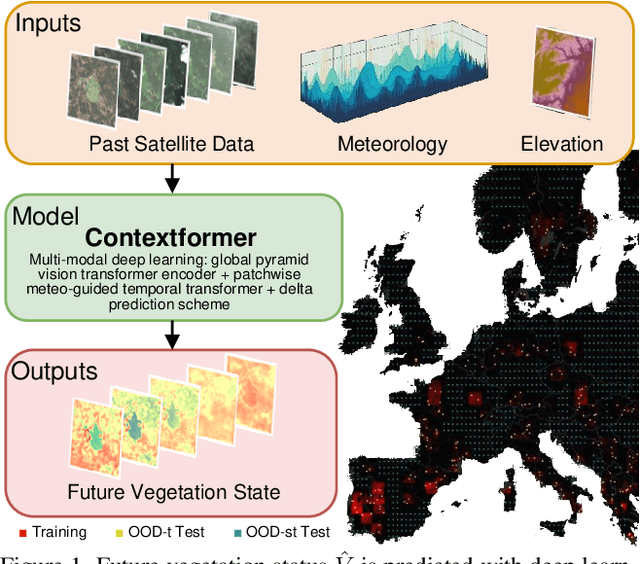
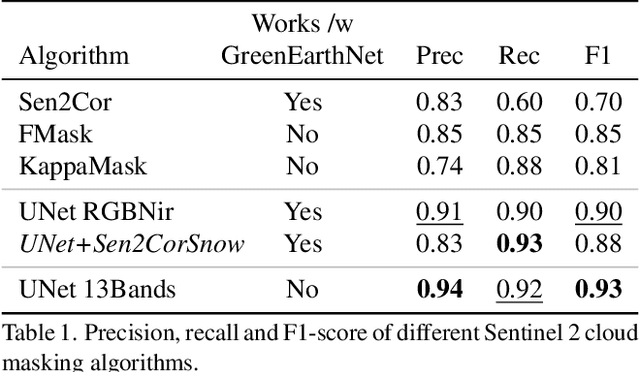

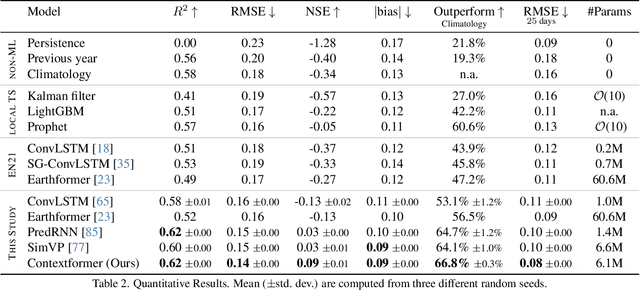
Abstract:We present a novel approach for modeling vegetation response to weather in Europe as measured by the Sentinel 2 satellite. Existing satellite imagery forecasting approaches focus on photorealistic quality of the multispectral images, while derived vegetation dynamics have not yet received as much attention. We leverage both spatial and temporal context by extending state-of-the-art video prediction methods with weather guidance. We extend the EarthNet2021 dataset to be suitable for vegetation modeling by introducing a learned cloud mask and an appropriate evaluation scheme. Qualitative and quantitative experiments demonstrate superior performance of our approach over a wide variety of baseline methods, including leading approaches to satellite imagery forecasting. Additionally, we show how our modeled vegetation dynamics can be leveraged in a downstream task: inferring gross primary productivity for carbon monitoring. To the best of our knowledge, this work presents the first models for continental-scale vegetation modeling at fine resolution able to capture anomalies beyond the seasonal cycle, thereby paving the way for predictive assessments of vegetation status.
Learning to forecast vegetation greenness at fine resolution over Africa with ConvLSTMs
Oct 24, 2022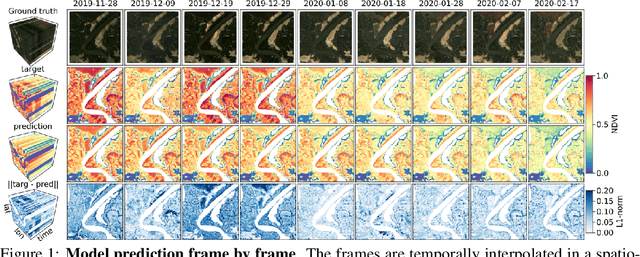

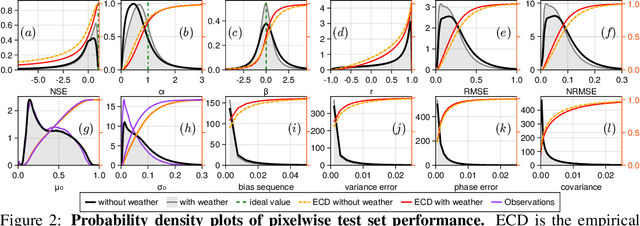
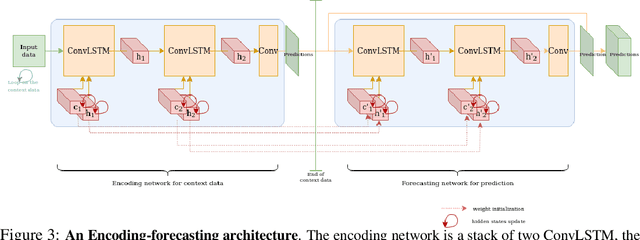
Abstract:Forecasting the state of vegetation in response to climate and weather events is a major challenge. Its implementation will prove crucial in predicting crop yield, forest damage, or more generally the impact on ecosystems services relevant for socio-economic functioning, which if absent can lead to humanitarian disasters. Vegetation status depends on weather and environmental conditions that modulate complex ecological processes taking place at several timescales. Interactions between vegetation and different environmental drivers express responses at instantaneous but also time-lagged effects, often showing an emerging spatial context at landscape and regional scales. We formulate the land surface forecasting task as a strongly guided video prediction task where the objective is to forecast the vegetation developing at very fine resolution using topography and weather variables to guide the prediction. We use a Convolutional LSTM (ConvLSTM) architecture to address this task and predict changes in the vegetation state in Africa using Sentinel-2 satellite NDVI, having ERA5 weather reanalysis, SMAP satellite measurements, and topography (DEM of SRTMv4.1) as variables to guide the prediction. Ours results highlight how ConvLSTM models can not only forecast the seasonal evolution of NDVI at high resolution, but also the differential impacts of weather anomalies over the baselines. The model is able to predict different vegetation types, even those with very high NDVI variability during target length, which is promising to support anticipatory actions in the context of drought-related disasters.
Physically-Consistent Generative Adversarial Networks for Coastal Flood Visualization
May 05, 2021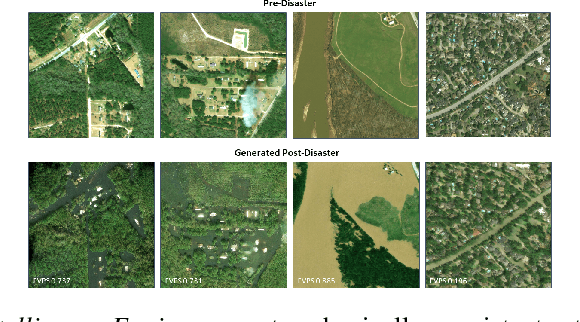


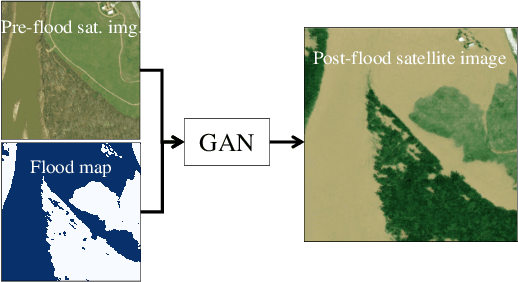
Abstract:As climate change increases the intensity of natural disasters, society needs better tools for adaptation. Floods, for example, are the most frequent natural disaster, and better tools for flood risk communication could increase the support for flood-resilient infrastructure development. Our work aims to enable more visual communication of large-scale climate impacts via visualizing the output of coastal flood models as satellite imagery. We propose the first deep learning pipeline to ensure physical-consistency in synthetic visual satellite imagery. We advanced a state-of-the-art GAN called pix2pixHD, such that it produces imagery that is physically-consistent with the output of an expert-validated storm surge model (NOAA SLOSH). By evaluating the imagery relative to physics-based flood maps, we find that our proposed framework outperforms baseline models in both physical-consistency and photorealism. We envision our work to be the first step towards a global visualization of how climate change shapes our landscape. Continuing on this path, we show that the proposed pipeline generalizes to visualize arctic sea ice melt. We also publish a dataset of over 25k labelled image-pairs to study image-to-image translation in Earth observation.
EarthNet2021: A large-scale dataset and challenge for Earth surface forecasting as a guided video prediction task
Apr 16, 2021
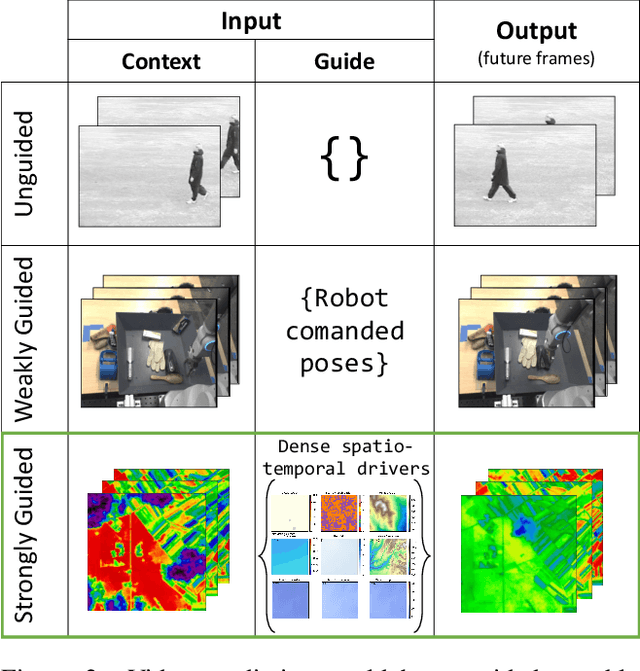
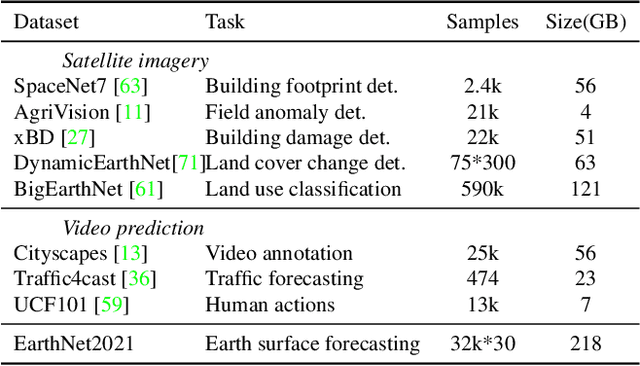
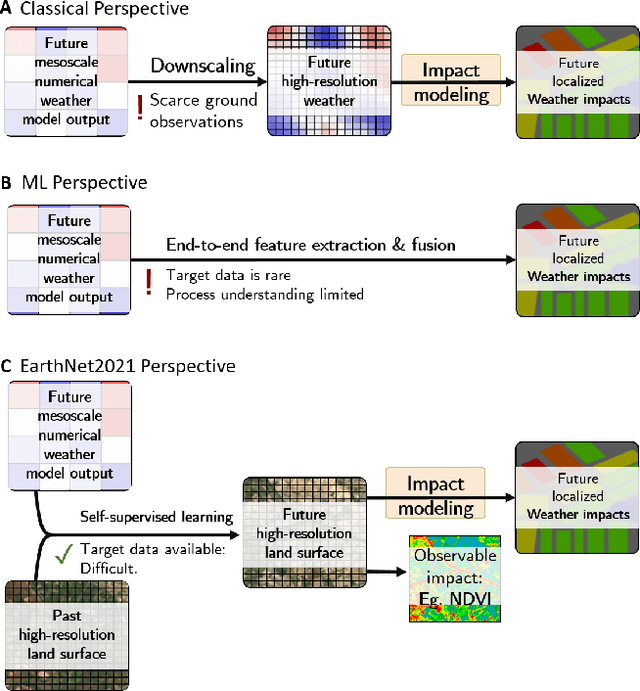
Abstract:Satellite images are snapshots of the Earth surface. We propose to forecast them. We frame Earth surface forecasting as the task of predicting satellite imagery conditioned on future weather. EarthNet2021 is a large dataset suitable for training deep neural networks on the task. It contains Sentinel 2 satellite imagery at 20m resolution, matching topography and mesoscale (1.28km) meteorological variables packaged into 32000 samples. Additionally we frame EarthNet2021 as a challenge allowing for model intercomparison. Resulting forecasts will greatly improve (>x50) over the spatial resolution found in numerical models. This allows localized impacts from extreme weather to be predicted, thus supporting downstream applications such as crop yield prediction, forest health assessments or biodiversity monitoring. Find data, code, and how to participate at www.earthnet.tech
EarthNet2021: A novel large-scale dataset and challenge for forecasting localized climate impacts
Dec 11, 2020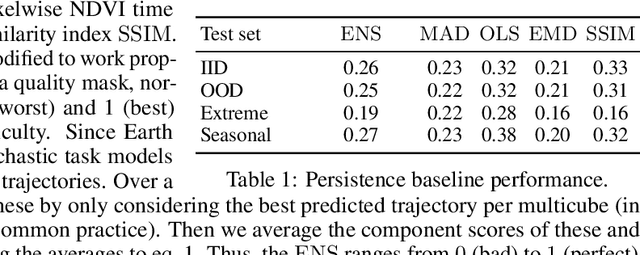
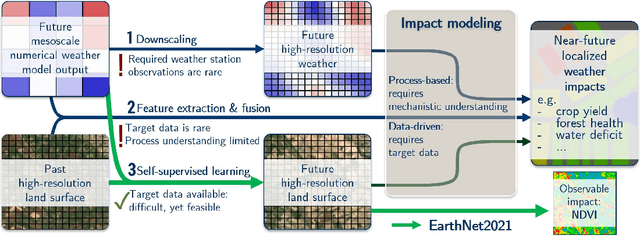
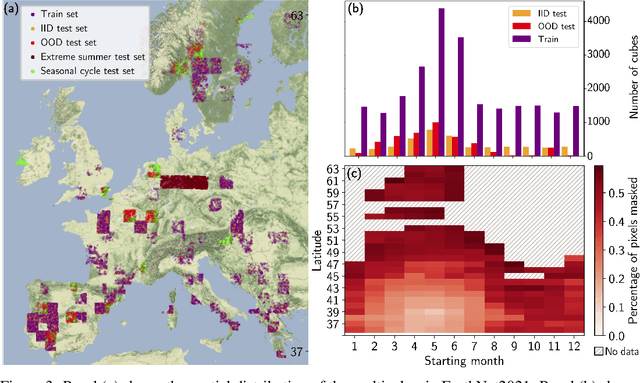
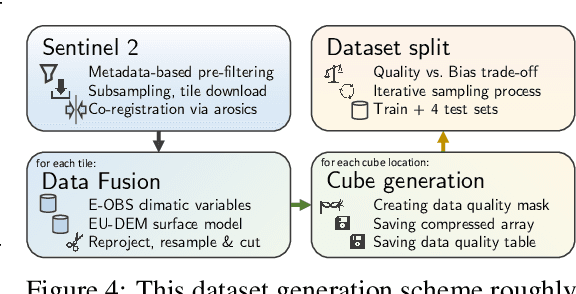
Abstract:Climate change is global, yet its concrete impacts can strongly vary between different locations in the same region. Seasonal weather forecasts currently operate at the mesoscale (> 1 km). For more targeted mitigation and adaptation, modelling impacts to < 100 m is needed. Yet, the relationship between driving variables and Earth's surface at such local scales remains unresolved by current physical models. Large Earth observation datasets now enable us to create machine learning models capable of translating coarse weather information into high-resolution Earth surface forecasts. Here, we define high-resolution Earth surface forecasting as video prediction of satellite imagery conditional on mesoscale weather forecasts. Video prediction has been tackled with deep learning models. Developing such models requires analysis-ready datasets. We introduce EarthNet2021, a new, curated dataset containing target spatio-temporal Sentinel 2 satellite imagery at 20 m resolution, matched with high-resolution topography and mesoscale (1.28 km) weather variables. With over 32000 samples it is suitable for training deep neural networks. Comparing multiple Earth surface forecasts is not trivial. Hence, we define the EarthNetScore, a novel ranking criterion for models forecasting Earth surface reflectance. For model intercomparison we frame EarthNet2021 as a challenge with four tracks based on different test sets. These allow evaluation of model validity and robustness as well as model applicability to extreme events and the complete annual vegetation cycle. In addition to forecasting directly observable weather impacts through satellite-derived vegetation indices, capable Earth surface models will enable downstream applications such as crop yield prediction, forest health assessments, coastline management, or biodiversity monitoring. Find data, code, and how to participate at www.earthnet.tech .
Physics-informed GANs for Coastal Flood Visualization
Oct 16, 2020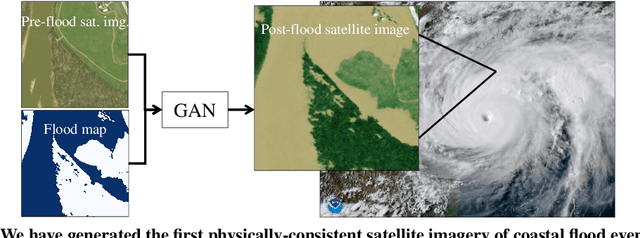



Abstract:As climate change increases the intensity of natural disasters, society needs better tools for adaptation. Floods, for example, are the most frequent natural disaster, but during hurricanes the area is largely covered by clouds and emergency managers must rely on nonintuitive flood visualizations for mission planning. To assist these emergency managers, we have created a deep learning pipeline that generates visual satellite images of current and future coastal flooding. We advanced a state-of-the-art GAN called pix2pixHD, such that it produces imagery that is physically-consistent with the output of an expert-validated storm surge model (NOAA SLOSH). By evaluating the imagery relative to physics-based flood maps, we find that our proposed framework outperforms baseline models in both physical-consistency and photorealism. While this work focused on the visualization of coastal floods, we envision the creation of a global visualization of how climate change will shape our earth.
Predicting Landscapes from Environmental Conditions Using Generative Networks
Sep 23, 2019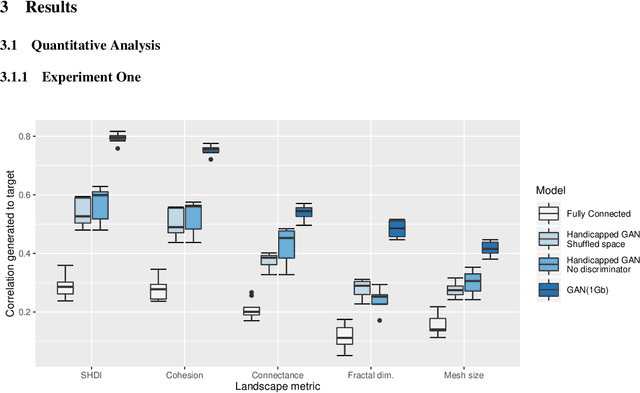

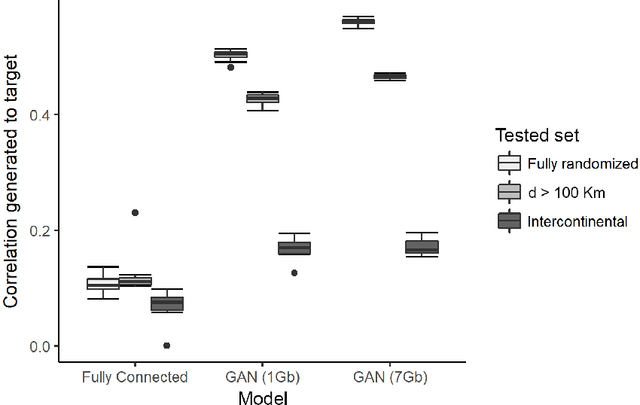
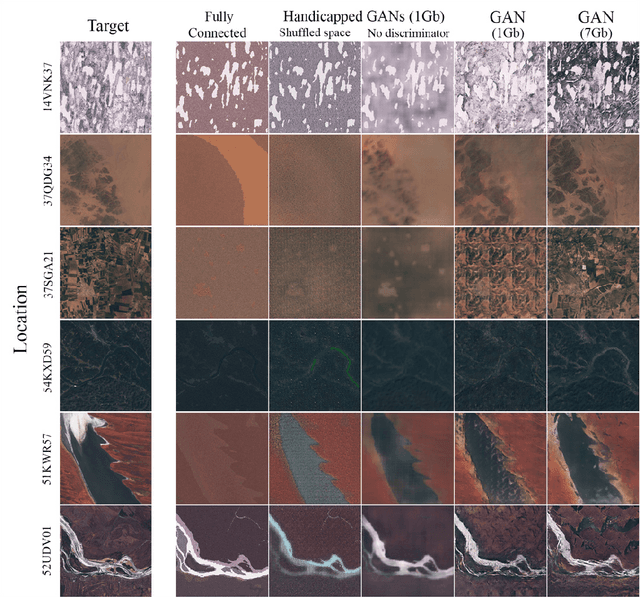
Abstract:Landscapes are meaningful ecological units that strongly depend on the environmental conditions. Such dependencies between landscapes and the environment have been noted since the beginning of Earth sciences and cast into conceptual models describing the interdependencies of climate, geology, vegetation and geomorphology. Here, we ask whether landscapes, as seen from space, can be statistically predicted from pertinent environmental conditions. To this end we adapted a deep learning generative model in order to establish the relationship between the environmental conditions and the view of landscapes from the Sentinel-2 satellite. We trained a conditional generative adversarial network to generate multispectral imagery given a set of climatic, terrain and anthropogenic predictors. The generated imagery of the landscapes share many characteristics with the real one. Results based on landscape patch metrics, indicative of landscape composition and structure, show that the proposed generative model creates landscapes that are more similar to the targets than the baseline models while overall reflectance and vegetation cover are predicted better. We demonstrate that for many purposes the generated landscapes behave as real with immediate application for global change studies. We envision the application of machine learning as a tool to forecast the effects of climate change on the spatial features of landscapes, while we assess its limitations and breaking points.
 Add to Chrome
Add to Chrome Add to Firefox
Add to Firefox Add to Edge
Add to Edge